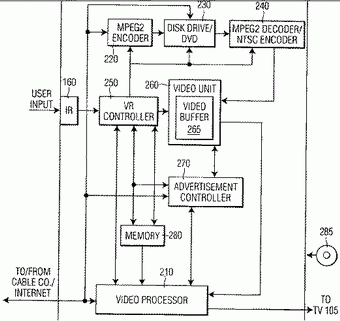Anti-Ad Blockers Sure to Irk Viewers

Inventors Philip Newton and Declan Kelly, at Philips Electronics (Eindhoven NL), have come up with a system to stop you from changing channels when viewing an ad and fast-forwarding past ads on recorded material.
(Click here to see full details of the patent.)
While this technology may not be exciting to the viewer, some non-subscription channels (TV) and recorded media companies may like the idea. Even subscription channels might like to keep their own promotional materials from being skipped over by viewers – Discovery Channel, take note.
Unfortunately for the inventors, there are some serious changes needed to existing hardware in order to make this work. For recorded material, however it’s a different story. Devices like the TIVO and other digital video recorders are all too easy to re-program. Devices that handle pay-per-view would also be good candidates.

To get an idea of how this technology feels, you need go no farther than your DVD player. There are times – especially during shorts and anti-piracy ads in the beginning of the video – that your remote control seems ineffective. You can’t fast forward or activate subtitles. You must watch the ads or restart the video. Instead of an action, you get the message “operation impossible” message flashing on your screen.
This new invention will feel much the same. It will detect the content via a special code, like “this segment is an ad” and proceed to disable your channel changer and fast forward buttons. The system will also pass these codes to recorded video and will continue preventing you from fast-forwarding past the ads.
Their system will also have the ability for users to be able to pay NOT to see the ads – nice, huh? It will accept payments made by pressing a special button and entering a code.
Once the ad is finished, the control will be returned to the user permitting him to change channels or fast-forward recorded footage.
It’s important to note that this is hardware as well as a software solution for the majority of devices on the market today. It could, however, start showing up in cable TV decoders, DVD players and DVRs – Digital Video Recorders – and even Internet. It could even be integrated into normal TV monitors. In fact, any playback device could use this technology. It should also temporally defeat any existing ad blocking systems since it’s a hardware solution.
While media producers and ad execs might like to see this technology, history has shown that customers don’t want it and won’t buy it - unless, of course, they have no choice.
A good example is the DVD player. Originally slated to be able to play only the DVDs in a given region, DVD player makers who offered multiregional support got all the sales. Now, very few DVD players are not multiregional units. The idea was to isolate the areas where much of the DVD piracy occurred – Asia and Latin America – was a good one, but market forces decided the technology’s fate in just a few years.
In fact, all attempts at forcing a specific behavior on users have resulted in a drop in market share and even potential lawsuits. Sony and DRM – Digital Rights Management -is probably the best example with its “root kit” that installs on a hard drive to protect copy written material. Check out this link to see if your computer has a root kit – a serious malware. (Click here for more on the DRM fiasco.)
It’s hard not to feel a little sorry for the ad execs – these days the customer has so many choices they can simply skip over the ads by changing channels. But any attempt at enforcing ad viewing with this type of technology is sure to result in serious customer resentment. Traditional broadcast TV audiences have been changing to cable and will continue to vote with their feet on any type return to entertainment straight jacketed by advertising.
Even if it is implemented, experts predict it will be just weeks before a hack is available on the Internet. Since it’s a hardware and software solution, however, the hack may be expensive and require add-on equipment like a converter box.
Customers may do what they have been by the millions – paying directly for entertainment rather than suffer though hundreds of ads for free viewing. This, of course, also is a big plus for media makers as they then receive their revenue directly from the paying public instead of ad agencies – the only big losers.
By Philip Dunn, Copyright 2006 PhysOrg.com















